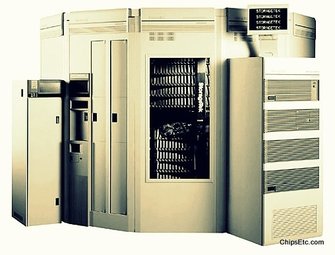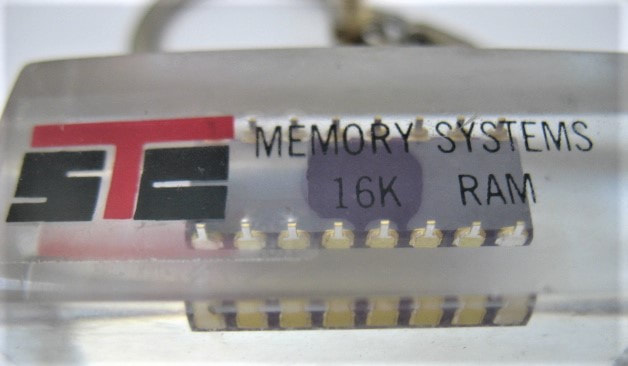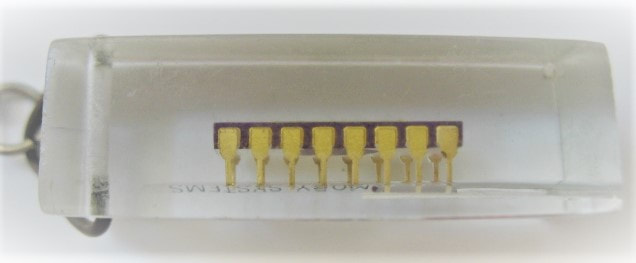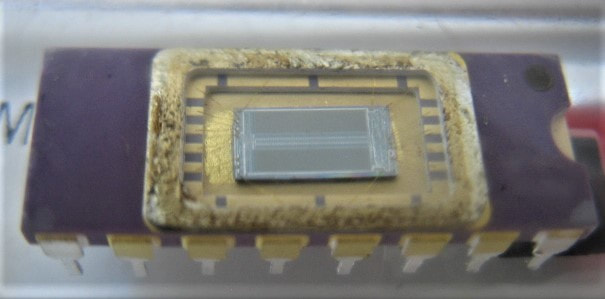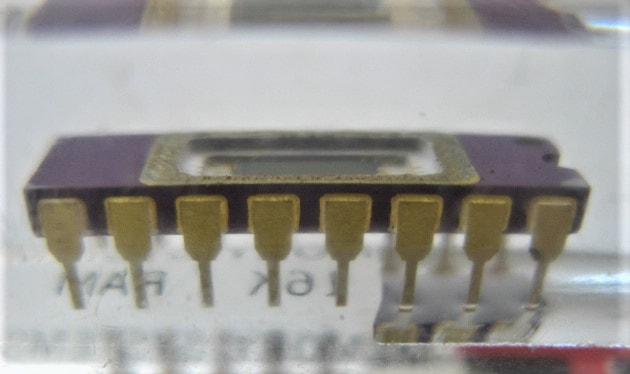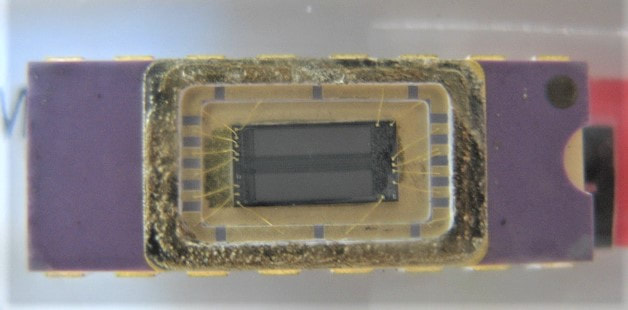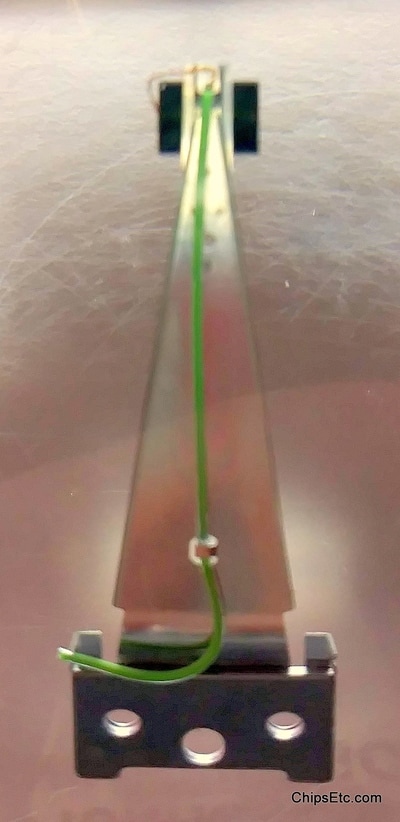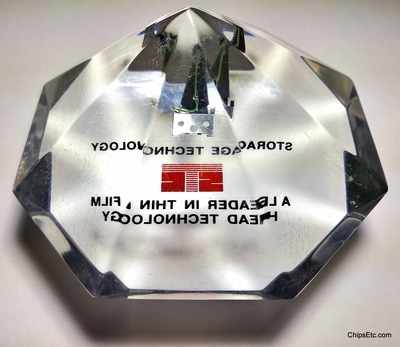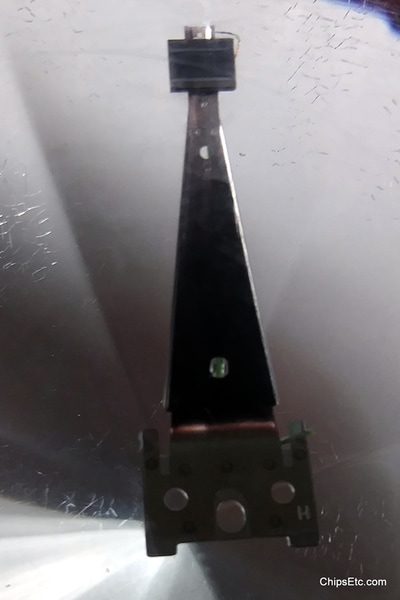|
Company: Storage Technology Corporation (STC)
Based: Louisville, Colorado Founded: 1969, renamed StorageTek (STK) in 1983, acquired by Sun Microsystems in 2005, then Oracle in 2010 Founders: Jesse Aweida, Juan Rodriguez, Thomas S. Kavanagh, and Zoltan Herger (former IBM engineers) Specialty: Mainframe computer storage peripherals and hardware including magnetic tape, optical and disk drives and arrays, RAM memory storage, printers, Automated modular tape library system. Developed first intelligent computer disk drive, world's first solid state drive SSD, and first cached disk drive. |
STC 16K RAM chip used in early SSD Solid state drives (1979)
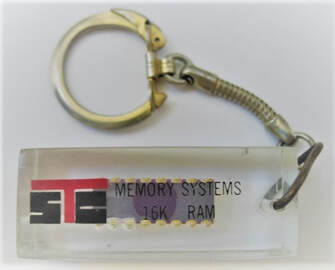
Item # 1012
This Lucite keychain from STC has a 16K DRAM memory chip encased in Lucite, manufacturer unknow. The chip comes in a purple, ceramic DIP package, with 16 gold plated pins. The top cap has been de-soldered so the die is exposed for viewing.
The earliest solid state drives (SSD) were computer storage subsystems that utilized solid-state memory located between the computer's main memory and fixed-head disk storage. These new SSD drives were direct plug-compatible replacements to the IBM 2301 fixed-head (drum) disk drives, and were up to seven times faster, and half the price.
The world's first SSD drive was the STC 4305, introduced in 1978. It had a capacity of 45MB and cost $400,000. The STC 4305 initially used CCD semiconductor technology as memory, but by 1979 STC would switch to using DRAM memory chips (as shown in the example in this item pictured).
Also in 1979, Intel Corp. would introduce their own version of the SSD drive, the Intel fast-3805 disk system. It also used 16k-bit DRAM memory chips.
The earliest solid state drives (SSD) were computer storage subsystems that utilized solid-state memory located between the computer's main memory and fixed-head disk storage. These new SSD drives were direct plug-compatible replacements to the IBM 2301 fixed-head (drum) disk drives, and were up to seven times faster, and half the price.
The world's first SSD drive was the STC 4305, introduced in 1978. It had a capacity of 45MB and cost $400,000. The STC 4305 initially used CCD semiconductor technology as memory, but by 1979 STC would switch to using DRAM memory chips (as shown in the example in this item pictured).
Also in 1979, Intel Corp. would introduce their own version of the SSD drive, the Intel fast-3805 disk system. It also used 16k-bit DRAM memory chips.
STC magnetic thin film disk storage head (1980)
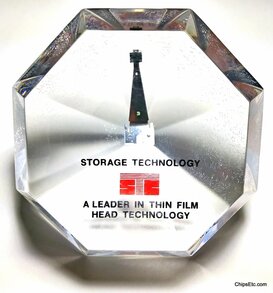
Item #965
This Lucite paperweight from STC features an example of their thin film head technology.
In the late 1970's to early 80's STC competed with Control Data Corp., Ampex, Sperry Univac, Intel, and Memorex to produce high density, plug-compatible, disk storage drive systems for IBM mainframe business computers.
STC would file for bankruptcy in 1985 due to high costs incurred while developing their own compatible version of the IBM 3380 magnetic disk storage system. STC also incurred further financial burden by competing with Trilogy Systems (Amdahl) & National Advanced Systems (NAS) to be first to introduce an air-cooled IBM compatible mainframe computer that used the new VLSI CMOS semiconductor manufacturing technology, replacing the industry's older bipolar semiconductor technology. The CMOS mainframe computer project was later dropped by STC.
Item measures 2" x 2" x 2".
In the late 1970's to early 80's STC competed with Control Data Corp., Ampex, Sperry Univac, Intel, and Memorex to produce high density, plug-compatible, disk storage drive systems for IBM mainframe business computers.
STC would file for bankruptcy in 1985 due to high costs incurred while developing their own compatible version of the IBM 3380 magnetic disk storage system. STC also incurred further financial burden by competing with Trilogy Systems (Amdahl) & National Advanced Systems (NAS) to be first to introduce an air-cooled IBM compatible mainframe computer that used the new VLSI CMOS semiconductor manufacturing technology, replacing the industry's older bipolar semiconductor technology. The CMOS mainframe computer project was later dropped by STC.
Item measures 2" x 2" x 2".

